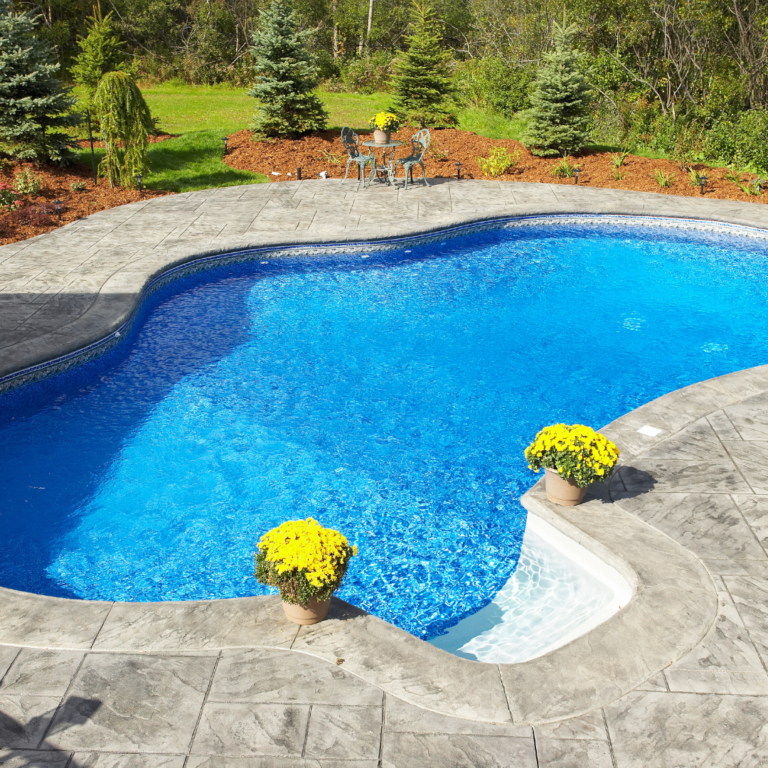When it comes to choosing the perfect pool for your backyard oasis, there are numerous options to consider. From traditional concrete to fiberglass, each type of pool comes with its own set of advantages and considerations. One option that has been gaining popularity in recent years is the vinyl pool. Read on for all the vinyl pool information you need.
Why Choose Vinyl?
Vinyl pools offer several compelling benefits, including:
- Affordability: Vinyl pools tend to be more budget-friendly compared to alternatives like concrete or fiberglass.
- Customization: With vinyl, you have the flexibility to create a pool that matches your unique style and preferences, from shape and size to color and design.
- Comfort: Vinyl pool surfaces are smooth to the touch, providing a comfortable swimming experience for you and your family.
- Durability: When properly maintained, vinyl pools can last for decades, making them a wise long-term investment for your property.
Construction Process
Here’s an overview of what you can expect during the construction process:
1. Excavation
The first step in building a vinyl pool is excavation. This involves digging out the area where the pool will be located, ensuring proper depth and dimensions according to the design specifications.
2. Framing
Once the excavation is complete, the next step is to construct the pool’s frame. This typically involves assembling a sturdy support structure made from materials such as steel or polymer, which will provide the foundation for the vinyl liner.
3. Plumbing and Electrical
With the frame in place, the plumbing and electrical systems are installed. This includes piping for water circulation, filtration, and any additional features such as water jets or lighting.
4. Installation of Vinyl Liner
The vinyl liner is one of the defining features of a vinyl pool. It is carefully measured and custom-fitted to the dimensions of the pool, ensuring a seamless and watertight finish. The liner is typically made from durable vinyl material, available in a variety of colors and patterns to suit your preferences.
5. Backfilling and Decking
Once the liner is in place, the area around the pool is backfilled to secure the structure and create a level surface. Decking materials such as concrete, pavers, or wood are then installed to surround the pool, providing both aesthetic appeal and functional space for lounging and entertaining.
Materials Matter
Here are some key materials to consider:
- Vinyl Liner: Opt for a high-quality vinyl liner that is resistant to punctures, fading, and deterioration from UV exposure.
- Frame: Choose a durable framing material such as galvanized steel or corrosion-resistant polymer to ensure the structural integrity of the pool.
- Plumbing and Filtration: Invest in high-quality plumbing and filtration components to maintain optimal water quality and circulation.
- Decking: Select decking materials that are durable, slip-resistant, and complementary to your outdoor aesthetic.
Maintaining Your Vinyl Pool
Proper maintenance is essential for maximizing the lifespan of your vinyl pool and ensuring years of enjoyment. Here are some tips for keeping your pool in top condition:
- Regular Cleaning: Skim the surface, vacuum the bottom, and brush the walls of your pool regularly to prevent algae growth and debris buildup.
- Balanced Water Chemistry: Test the water regularly and adjust the chemical balance as needed to maintain proper pH, alkalinity, and sanitizer levels.
- Protective Measures: Use a pool cover when the pool is not in use to prevent debris from entering and to minimize evaporation and heat loss.
- Annual Inspections: Schedule annual inspections with a professional pool technician to check for any signs of damage or wear and tear that may require repairs or replacement.
Long-Term Durability
One of the key selling points of vinyl pools is their long-term durability when properly maintained. With routine care and maintenance, a vinyl pool can last upwards of 20 years or more, providing countless hours of enjoyment for you and your family.
Frequently Asked Questions (FAQs)
Here are answers to a few FAQs to help you navigate the decision-making process:
Q: Are vinyl pools prone to punctures or tears? A: While vinyl liners can be punctured by sharp objects or improper maintenance, modern vinyl materials are designed to be durable and resistant to tears. By following proper care and maintenance guidelines, you can minimize the risk of damage to your vinyl pool.
Q: Can vinyl pool liners be repaired if damaged? A: Yes, minor tears or punctures in a vinyl liner can often be repaired using patch kits available from pool supply stores. For larger or more extensive damage, professional repair or replacement may be necessary.
Q: How long does it take to install a vinyl pool? A: The installation timeline for a vinyl pool can vary depending on factors such as size, complexity, and local regulations. In general, the construction process typically takes several weeks from excavation to completion.
Q: Can I change the design or shape of my vinyl pool after it’s installed? A: While it is possible to make minor modifications or additions to a vinyl pool after installation, major changes to the design or shape may require extensive renovations or replacement of the vinyl liner.
Conclusion
In conclusion, vinyl pools offer a cost-effective, customizable, and durable option for homeowners seeking to enhance their outdoor living space with a swimming pool.

